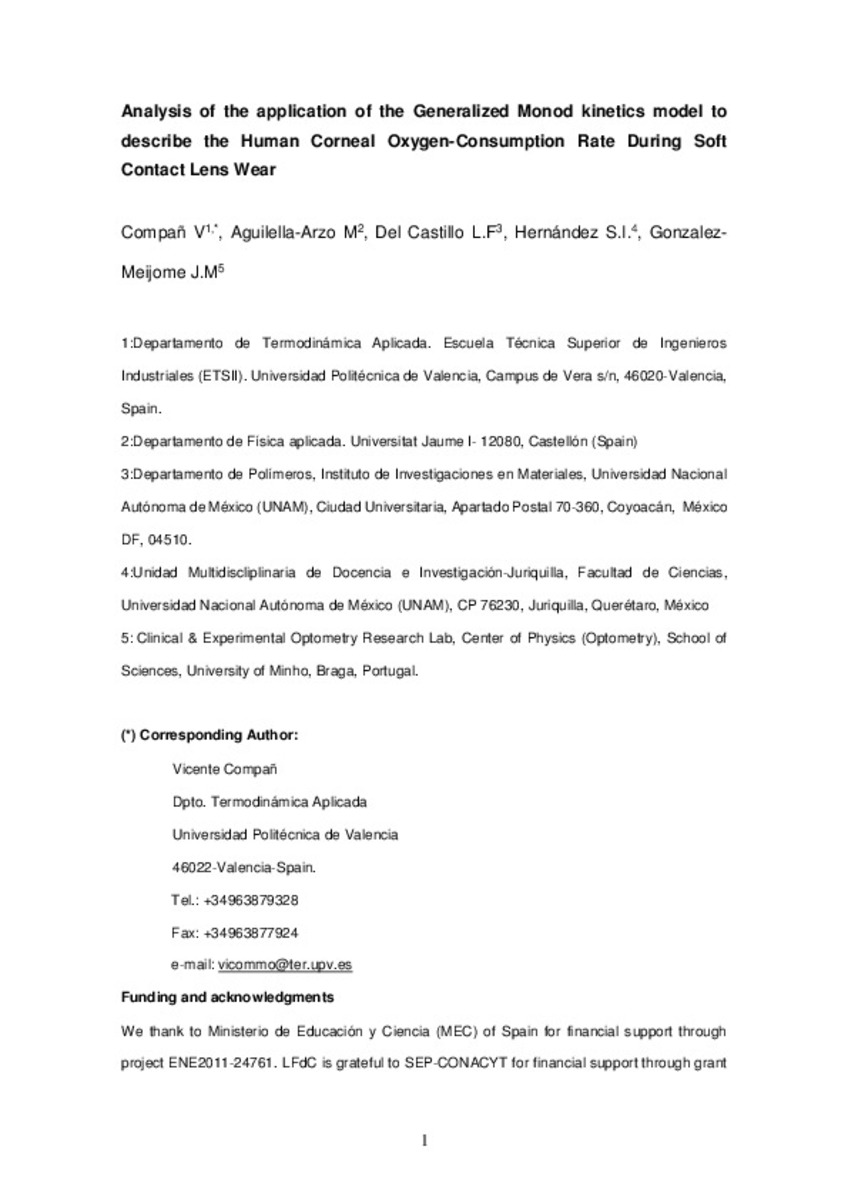Mostrar el registro sencillo del ítem
Analysis of the application of the generalized monod kinetics model to describe the human corneal oxygen-consumption rate during soft contact lens wear
| dc.contributor.author | Compañ, Vicente | |
| dc.contributor.author | Aguilella-Arzo, Marcel | |
| dc.contributor.author | Del Castillo, Luis F. | |
| dc.contributor.author | Hernández, Saúl Iván | |
| dc.contributor.author | González Méijome, J.M. | |
| dc.date.accessioned | 2017-12-21T11:03:47Z | |
| dc.date.available | 2017-12-21T11:03:47Z | |
| dc.date.issued | 2017-10 | |
| dc.identifier.citation | COMPAÑ, V., et al. Analysis of the application of the generalized monod kinetics model to describe the human corneal oxygen‐consumption rate during soft contact lens wear. Journal of Biomedical Materials Research Part B: Applied Biomaterials, 2017, vol. 105, no 8, p. 2269-2281. | ca_CA |
| dc.identifier.uri | http://hdl.handle.net/10234/171308 | |
| dc.description.abstract | This work is an analysis of the application of the generalized Monod kinetics model describing human corneal oxygen consumption during soft contact lens wear to models previously used by Chhabra et al. (J Biomed Mater Res B Appl Biomater, 2009a;90:202-209, Optom Vis Sci 2009b;86:454-466) and Larrea and Büchler (Invest Ophthalmol Vis Sci 2009;50:1076-1080). We use oxygen tension from in vivo estimations provided by Bonanno [Bonanno et al., Invest Ophthalmol Vis Sci 2002;43:371-376, and Bonanno et al 2009]. We consider four hydrogel and six silicone hydrogel lenses. The cornea is considered a single homogeneous layer, with constant oxygen permeability regardless of the type of lens worn. Our calculations yield different values for the maximum oxygen consumption rate Qc,max, whith differents oxygen tensions (high and low pc) at the cornea-tears interface. Surprisingly, for both models, we observe an increase in oxygen consumption near an oxygen tension of 105 mmHg until a maximum is reached, then decreasing for higher levels of oxygen pressure. That is, when lowering the pressure of oxygen, the parameter Qc,max initially increases depending on the intensity of the change in pressure. Which, it could be related with the variation of the pH. Furthermore, it is also noted that to greater reductions in pressure, this parameter decreases, possibly due to changes in the concentration of glucose related to the anaerobic respiration. The averaged in vivo human corneal oxygen consumption rate of 1.47 × 10−4 cm3 of O2/cm3 tissue s, with Monod kinetics model, considering all the lenses studied, is smaller than the average oxygen consumption rate value obtained using the Larrea and Büchler model. The impact that these calculations have on the oxygen partial pressure available at different depths in the corneal tissue is presented and discussed, taking into consideration previous models used in this study. | ca_CA |
| dc.format.extent | 12 p. | ca_CA |
| dc.format.mimetype | application/pdf | ca_CA |
| dc.language.iso | eng | ca_CA |
| dc.publisher | Wiley | ca_CA |
| dc.rights | © 2016 Wiley Periodicals, Inc. | ca_CA |
| dc.rights.uri | http://rightsstatements.org/vocab/InC/1.0/ | * |
| dc.subject | soft contact lenses | ca_CA |
| dc.subject | Monod kinetics model | ca_CA |
| dc.subject | oxygen consumption | ca_CA |
| dc.subject | oxygen tension | ca_CA |
| dc.subject | cornea | ca_CA |
| dc.title | Analysis of the application of the generalized monod kinetics model to describe the human corneal oxygen-consumption rate during soft contact lens wear | ca_CA |
| dc.type | info:eu-repo/semantics/article | ca_CA |
| dc.identifier.doi | http://dx.doi.org/10.1002/jbm.b.33764 | |
| dc.relation.projectID | Ministerio de Educación y Ciencia of Spain (ENE2011-24761) ; SEP-CONACYT (154626) ; UNAM-DGAPA (IG-100315 [to LFdC] ) | ca_CA |
| dc.rights.accessRights | info:eu-repo/semantics/openAccess | ca_CA |
| dc.relation.publisherVersion | http://onlinelibrary.wiley.com/doi/10.1002/jbm.b.33764/full | ca_CA |
| dc.contributor.funder | SIH is grateful to projects CONACYT SEP-2004-C01-47070, UNAM-DGAPA-PAPIIT IN113415, DGTIC-UNAM SC16-1-IR-113, to the Red Temática de la Materia Condensada Blanda-CONACYT for a postdoctoral fellowship, and to CONACYT for a retention fellowship No. 207109 | ca_CA |
| dc.type.version | info:eu-repo/semantics/submittedVersion | ca_CA |
Ficheros en el ítem
Este ítem aparece en la(s) siguiente(s) colección(ones)
-
FCA_Articles [501]
Articles de publicacions periódiques







